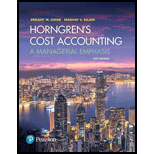
1.
Cost-Volume-Profit Analysis (CVP Analysis):
CVP Analysis is a tool of cost accounting that measures the effect of variation on operating profit and net income due to the variation in proportion of sales and product costs.
Break-Even Point:
Break-even point is a point of sales where company can cover all its variable and fixed costs. It is a point of sales where revenue generated is equal to the total costs. Thus, profit is zero at this level of sales.
Contribution Margin Percentage:
Contribution margin percentage is the excess of selling price over variable cost demonstrated in percentage.
To compute: Break-even point.
2.
To compute: Total contribution margin and operating income when 175,000 units are sold.
3.
To compute: Total contribution margin and operating income when 175,000 units are sold.
4.
To explain: Comparison between break-even point in point 1 and 2. Lower break-even points are not always better.
Want to see the full answer?
Check out a sample textbook solution
Chapter 3 Solutions
Horngren's Cost Accounting: A Managerial Emphasis (16th Edition)
- Please help!arrow_forwardFILL ALL CELLS. NOTICE THE DROPDOWN OPTIONSarrow_forwardABF's metal spare parts manufacturing company uses the customised production method by attributing the GST to the products it produces with the help of predetermined attribution coefficients. The processing of metal parts is carried out in two production departments: the Cutting and Drilling department, and the Assembly department. The GIS attribution coefficients for the two departments are based on the operating hours of machines and the cost of direct work respectively. At the beginning of the year, the following budgets were implemented: Cutting and Drilling Department Assembly Department Direct Labor Costs (in euros) 1.320.000 2.000.000 G.B.E. (in euros) 4.800.000 2.400.000 Machinery Operating Hours 80.000 5.000 Direct Work Hours 27.000 12.000 Requested: To calculate the coefficient of attribution of the General Secretariat that will be used in each department. (4 units) To determine the production cost per unit for order 158 which…arrow_forward
- PLEASE HELP. I HAVE PROVIDED THE DROPDOWN OPTIONSarrow_forwardThe difference between the balance in a company's cash account and its bank statement is documented in the __________ of the bank statement.arrow_forwardLarge corporations should report revenues on their income statements when the __________. Cash Is Received Revenues Are Earnedarrow_forward
- PLEASE HELP WITH THIS PROBLEMarrow_forwardThe KLM Medical Clinic has two auxiliary departments: the Building Maintenance Department and the Energy Production Department as well as three main production departments: the Department of Paediatrics, the Department of Internal Medicine and the Department of Surgery. The CLM allocates the cost of the building maintenance department based on the area occupied by the departments in square meters and the cost of the energy department based on the days of hospitalization of patients. No distinction is made between variable and fixed cost elements. The budgeted operating figures for the previous year were as follows: Auxiliary sections Main production departments Building maintenance Energy production Pediatrics Department of Internal Medicine Surgical Estimated cost before allocation 18.000,00 8.000,00 80.000,00 50.000,00 90.000,00 Area (in sq.m) 1.000,00 4.000,00 6.000,00 18.000,00 12.000,00 Patient Hospitalization…arrow_forwardwhat is financial accounting? explain its parts and all things.arrow_forward
- Principles of Accounting Volume 2AccountingISBN:9781947172609Author:OpenStaxPublisher:OpenStax College
 Cornerstones of Cost Management (Cornerstones Ser...AccountingISBN:9781305970663Author:Don R. Hansen, Maryanne M. MowenPublisher:Cengage Learning
Cornerstones of Cost Management (Cornerstones Ser...AccountingISBN:9781305970663Author:Don R. Hansen, Maryanne M. MowenPublisher:Cengage Learning

